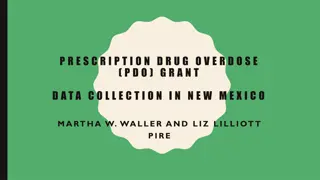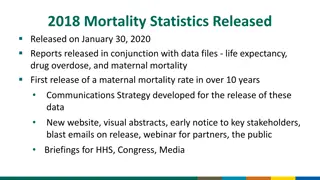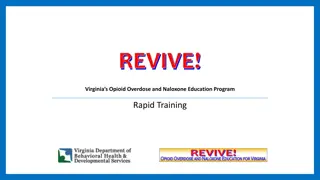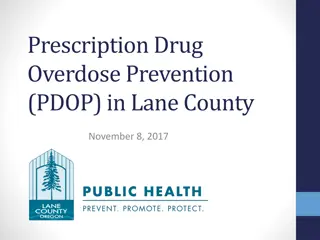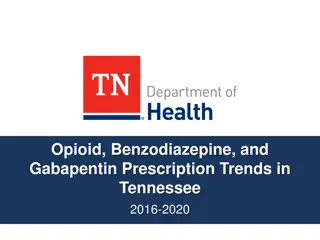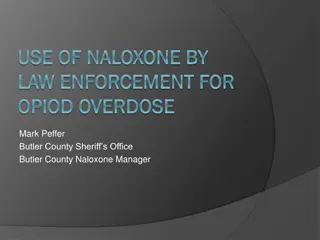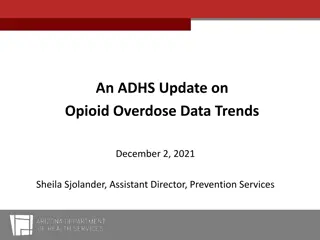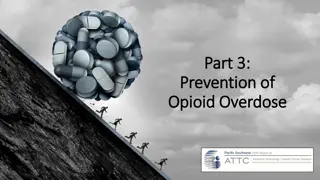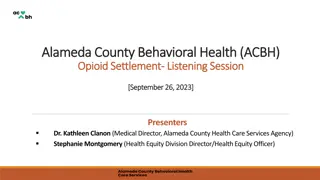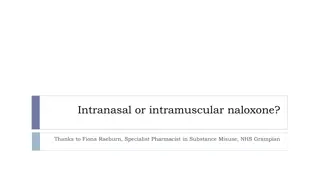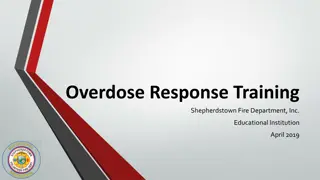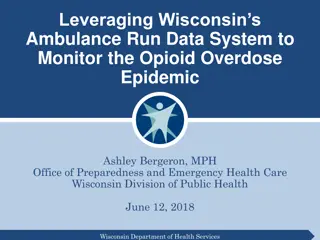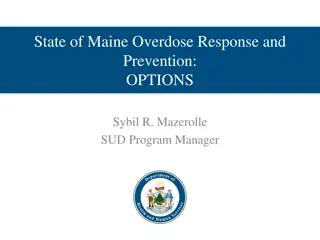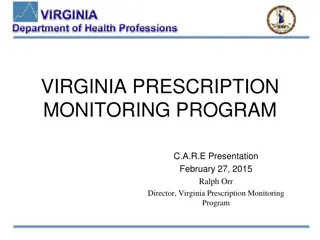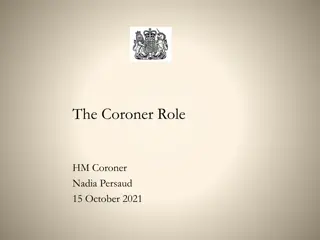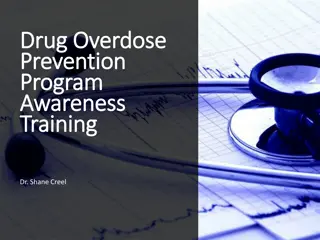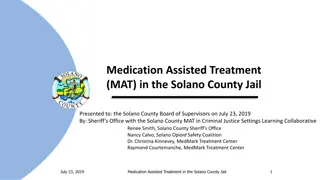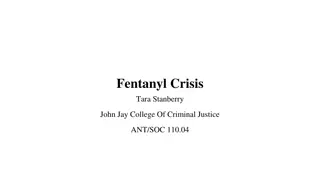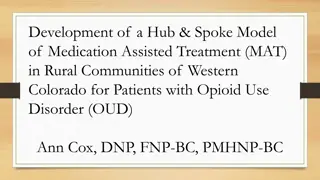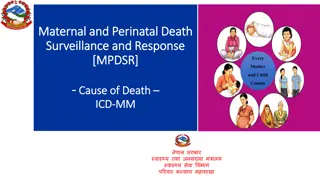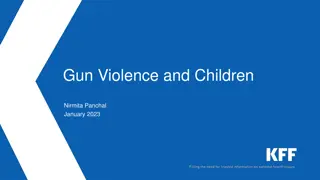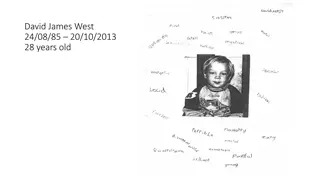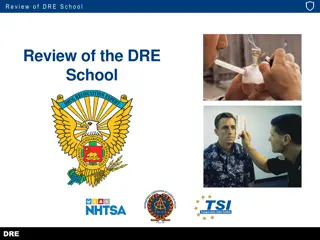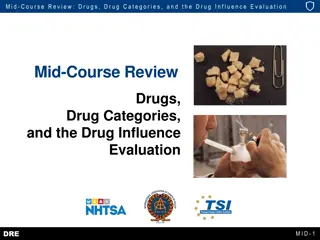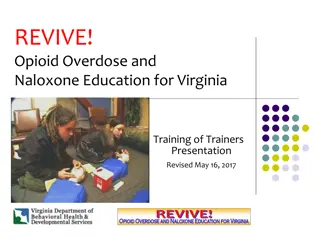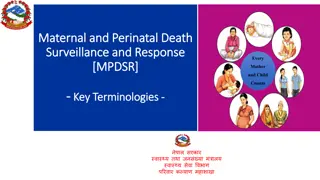Trends in National Drug-Involved Overdose Deaths from 1999-2020
The figures depict the alarming rise in drug-involved overdose deaths in the United States over the period 1999-2020. Figure 1 shows the number of deaths by gender, Figure 2 highlights specific drug categories involved, Figure 3 focuses on opioid-related deaths categorized by gender, and Figure 4 details overdose deaths involving prescription opioids. The data reveals a significant increase in overdose fatalities, particularly involving synthetic opioids and prescription drugs.
Uploaded on Sep 16, 2024 | 0 Views
Download Presentation

Please find below an Image/Link to download the presentation.
The content on the website is provided AS IS for your information and personal use only. It may not be sold, licensed, or shared on other websites without obtaining consent from the author. Download presentation by click this link. If you encounter any issues during the download, it is possible that the publisher has removed the file from their server.
E N D
Presentation Transcript
Figure 1. National Drug-Involved Overdose Deaths* Number Among All Ages, by Gender, 1999-2020 100,000 Total Female Male 91,799 80,000 70,630 60,000 52,404 40,000 20,000 0 *Includes deaths with underlying causes of unintentional drug poisoning (X40 X44), suicide drug poisoning (X60 X64), homicide drug poisoning (X85), or drug poisoning of undetermined intent (Y10 Y14), as coded in the International Classification of Diseases, 10th Revision. Source: Centers for Disease Control and Prevention, National Center for Health Statistics. Multiple Cause of Death 1999-2020 on CDC WONDER Online Database, released 12/2021.
Figure 2. National Drug-Involved Overdose Deaths*, Number Among All Ages, 1999-2020 60,000 50,000 Synthetic Opioids other than Methadone (primarily fentanyl) 40,000 Psychostimulants with Abuse Potential (primarily methamphetamine) Cocaine 30,000 Prescription Opioids (natural & semi-synthetic opioids & methadone) 20,000 Heroin Benzodiazepines 10,000 Antidepressants 0 2013 1999 2000 2001 2002 2003 2004 2005 2006 2007 2008 2009 2010 2011 2012 2014 2015 2016 2017 2018 2019 2020 *Includes deaths with underlying causes of unintentional drug poisoning (X40 X44), suicide drug poisoning (X60 X64), homicide drug poisoning (X85), or drug poisoning of undetermined intent (Y10 Y14), as coded in the International Classification of Diseases, 10th Revision. Source: Centers for Disease Control and Prevention, National Center for Health Statistics. Multiple Cause of Death 1999-2020 on CDC WONDER Online Database, released 12/2021.
Figure 3. National Overdose Deaths Involving Any Opioid, Number Among All Ages, by Gender, 1999-2020 100,000 Total Female Male 80,000 68,630 60,000 47,600 40,000 21,089 20,000 0 2006 2015 1999 2000 2001 2002 2003 2004 2005 2007 2008 2009 2010 2011 2012 2013 2014 2016 2017 2018 2019 2020 *Among deaths with drug overdose as the underlying cause, the any opioid subcategory was determined by the following ICD-10 multiple cause-of-death codes: natural and semi-synthetic opioids (T40.2), methadone (T40.3), other synthetic opioids (other than methadone) (T40.4), or heroin (T40.1). Source: Centers for Disease Control and Prevention, National Center for Health Statistics. Multiple Cause of Death 1999-2020 on CDC WONDER Online Database, released 12/2021.
Figure 4. National Overdose Deaths Involving Prescription Opioids*, Number Among All Ages, 1999-2020 25,000 Total Prescription Opioids in Combination with Synthetic Opioids other than Methadone Prescription Opioids without any other Opioid 20,000 17,029 16,416 14,139 15,000 10,000 5,000 0 1999 2000 2001 2002 2003 2004 2005 2007 2008 2009 2010 2011 2012 2013 2014 2015 2016 2017 2018 2019 2020 2006 *Among deaths with drug overdose as the underlying cause, the prescription opioid subcategory was determined by the following ICD-10 multiple cause-of-death codes: natural and semi-synthetic opioids (T40.2) or methadone (T40.3). Source: Centers for Disease Control and Prevention, National Center for Health Statistics. Multiple Cause of Death 1999-2020 on CDC WONDER Online Database, released 12/2021.
Figure 5. National Overdose Deaths Involving Heroin*, by other Opioid Involvement, Number Among All Ages, 1999- 2020 25,000 All Heroin Heroin in Combination with Synthetic Opioids other than Methadone Heroin without any Other Opioid 20,000 15,469 15,000 13,165 10,000 5,000 0 2014 2019 1999 2000 2001 2002 2003 2004 2005 2006 2007 2008 2009 2010 2011 2012 2013 2015 2016 2017 2018 2020 *Among deaths with drug overdose as the underlying cause, the heroin category was determined by the T40.1 ICD-10 multiple cause-of-death code. Source: Centers for Disease Control and Prevention, National Center for Health Statistics. Multiple Cause of Death 1999-2020 on CDC WONDER Online Database, released 12/2021.
Figure 6. National Overdose Deaths Involving Psychostimulants with Abuse Potential (Primarily Methamphetamine)*, by Opioid Involvement, Number Among All Ages, 1999-2020 50,000 All Psychostimulants Psychostimulants in Combination with Synthetic Opioids other than Methadone Psychostimulants without any Opioid 40,000 30,000 23,837 20,000 10,000 5,716 0 1999 2000 2001 2002 2003 2004 2005 2006 2007 2008 2009 2010 2011 2012 2013 2014 2015 2016 2017 2018 2019 2020 *Among deaths with drug overdose as the underlying cause, the psychostimulants with abuse potential (primarily methamphetamine) category was determined by the T43.6 ICD-10 multiple cause-of-death code. Abbreviated to psychostimulants in the bar chart above. Source: Centers for Disease Control and Prevention, National Center for Health Statistics. Multiple Cause of Death 1999-2020 on CDC WONDER Online Database, released 12/2021.
Figure 7. National Drug Overdose Deaths Involving Cocaine*, by Opioid Involvement, Number Among All Ages, 1999-2020 25,000 All Cocaine Cocaine in Combination with Synthetic Opioids other than Methadone Cocaine without any Opioid 19,447 20,000 15,000 10,000 5,415 5,000 0 2006 2008 2010 2012 1999 2000 2001 2002 2003 2004 2005 2007 2009 2011 2013 2014 2015 2016 2017 2018 2019 2020 *Among deaths with drug overdose as the underlying cause, the cocaine category was determined by the T40.5 ICD-10 multiple cause-of-death code. Source: Centers for Disease Control and Prevention, National Center for Health Statistics. Multiple Cause of Death 1999-2020 on CDC WONDER Online Database, released 12/2021.
Figure 8. National Drug Overdose Deaths Involving Benzodiazepines*, by Opioid Involvement, Number Among All Ages, 1999-2020 25,000 All Benzodiazepines Benzodiazepines in Combination with Synthetic Opioids other than Methadone Benzodiazepines without any Opioid 20,000 15,000 12,290 11,537 9,711 10,000 5,000 0 2008 2018 1999 2000 2001 2002 2003 2004 2005 2006 2007 2009 2010 2011 2012 2013 2014 2015 2016 2017 2019 2020 *Among deaths with drug overdose as the underlying cause, the benzodiazepine category was determined by the T42.4 ICD-10 multiple cause-of-death code. Source: Centers for Disease Control and Prevention, National Center for Health Statistics. Multiple Cause of Death 1999-2020 on CDC WONDER Online Database, released 12/2021.
Figure 9. National Drug Overdose Deaths Involving Antidepressants, by Opioid Involvement, Number Among All Ages, 1999-2020 All Antidepressants Antidepressants in Combination with Synthetic Opioids other than Methadone Antidepressants without any Opioid 10,000 8,000 5,597 6,000 5,269 4,000 1,749 2,000 0 *Among deaths with drug overdose as the underlying cause, the antidepressant subcategory was determined by the following ICD-10 multiple cause-of-death codes: Tricyclic and tetracyclic antidepressants (T43.0), monoamine-oxidase-inhibitor antidepressants (T43.1), and other unspecified antidepressants (T43.2). Source: Centers for Disease Control and Prevention, National Center for Health Statistics. Multiple Cause of Death 1999-2020 on CDC WONDER Online Database, released 12/2021.
Alternative Text The figures above are bar charts showing the number of U.S. overdose deaths involving select prescription and illicit drugs from 1999 through 2020. The bars are overlaid by lines representing gender or concurrent opioid involvement. There were 91,799 drug-involved overdose deaths reported in the U.S. in 2020 (Figure 1); 69% of cases occurred among males (yellow line). Synthetic opioids other than methadone (primarily fentanyl) were the main driver of drug overdose deaths with a 6-fold increase from 2015 to 2020 (Figure 2). Drug overdose deaths involving any opioid prescription opioids (including natural and semi- synthetic opioids and methadone), other synthetic opioids other than methadone (primarily fentanyl), and heroin continued to rise through 2020 with 68,630 deaths. More than 70% of deaths occurred among males (Figure 3). From 2019 to 2020, the number of deaths involving prescription opioids rose, after remaining steady for two years, to 16,416 (Figure 4). Overdose deaths involving heroin has trended down since 2016 with 13,165 deaths reported in 2020 (Figure 5). More than 68% of overdose deaths involving heroin also involved synthetic opioids other than methadone (primarily fentanyl). Since 2014, the number of deaths involving psychostimulants (primarily methamphetamine, Figure 6) have risen significantly each year, with 23,837 deaths in 2020. Cocaine too, has increased steadily since 2014 with 19,447 deaths reported in 2020 (Figure 7). The final two charts show the number of overdose deaths involving benzodiazepines (Figure 8) or antidepressants (Figure 9). Benzodiazepines were involved in 12,290 deaths in 2020 a steady decline from the 11,537 deaths in 2017. Deaths involving antidepressants have remained steady since 2014, with 5,597 fatalities reported in 2020. Deaths involving benzodiazepines or antidepressants are mainly driven by those also involving opioids.


